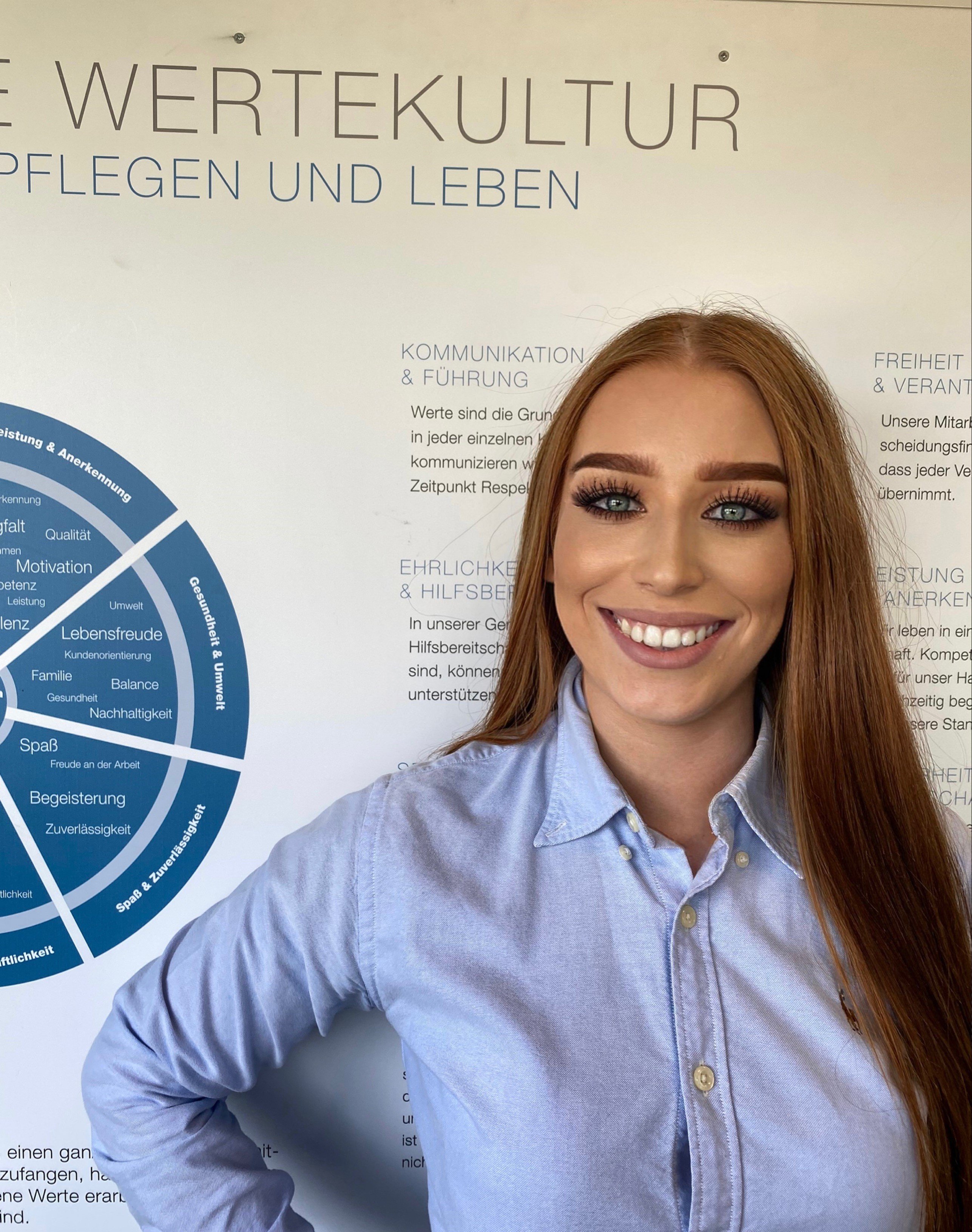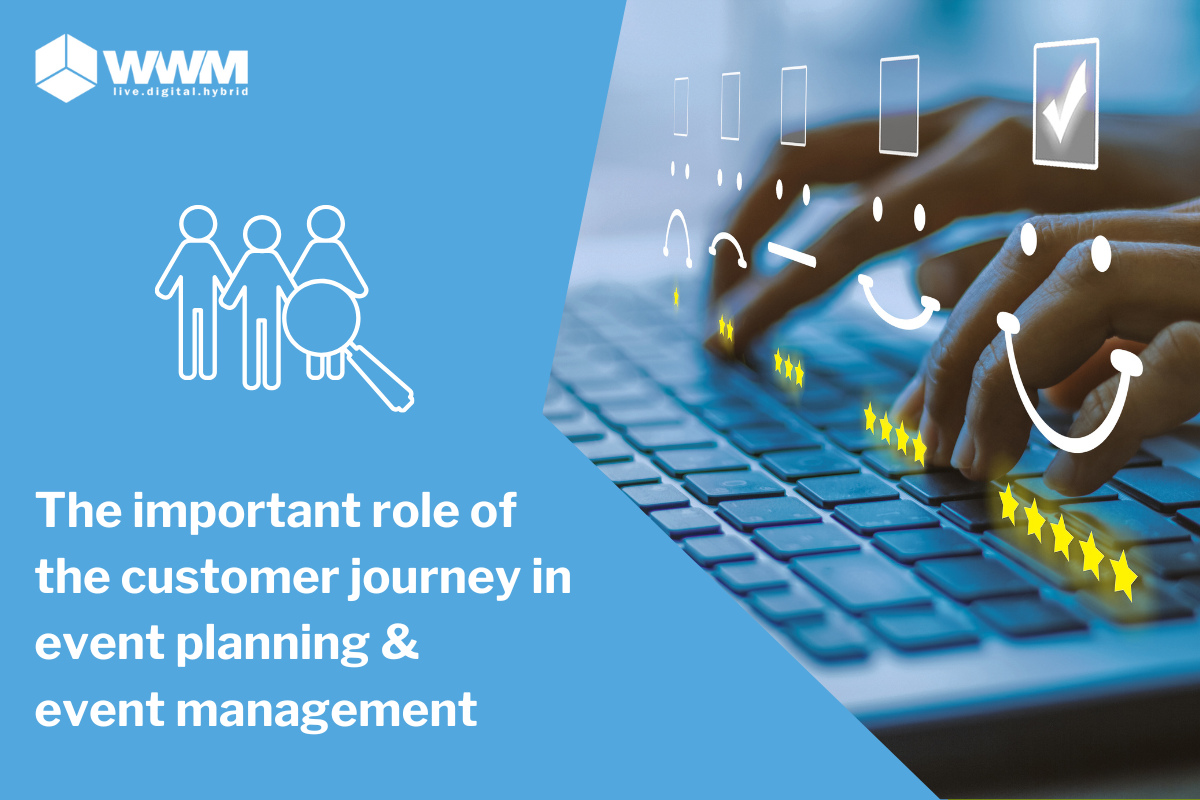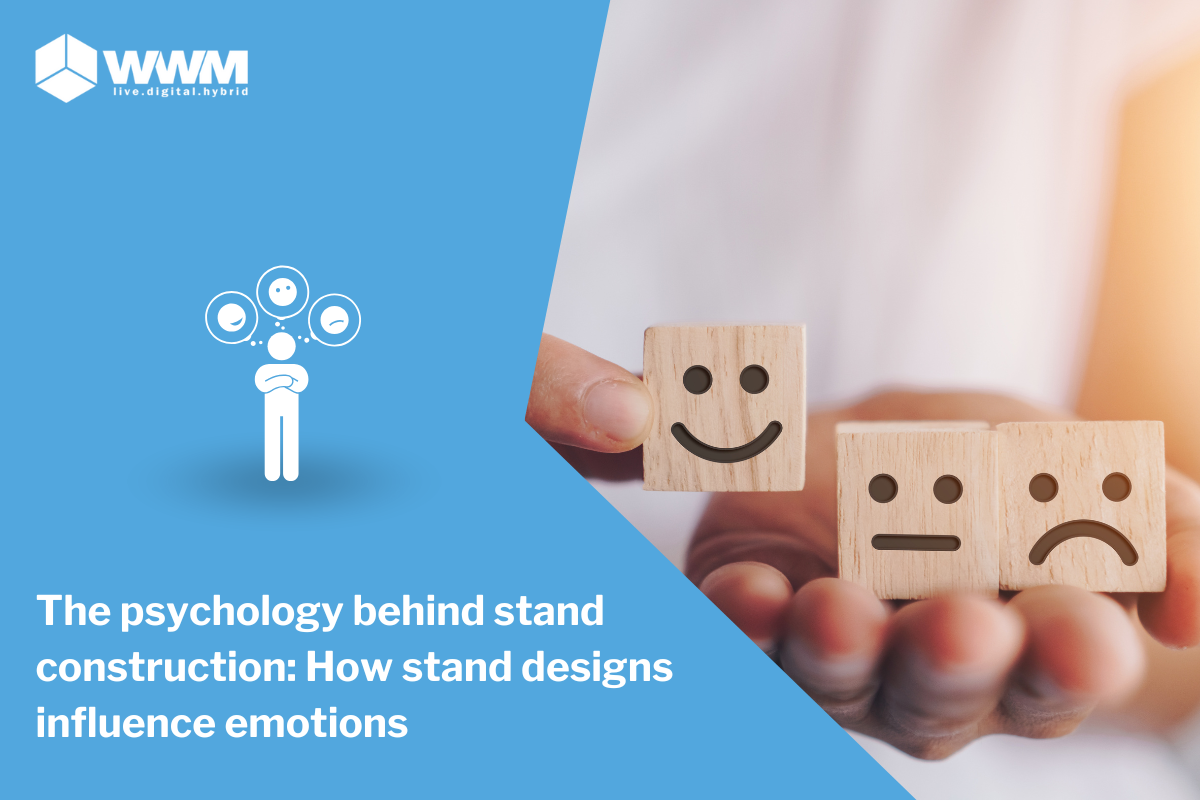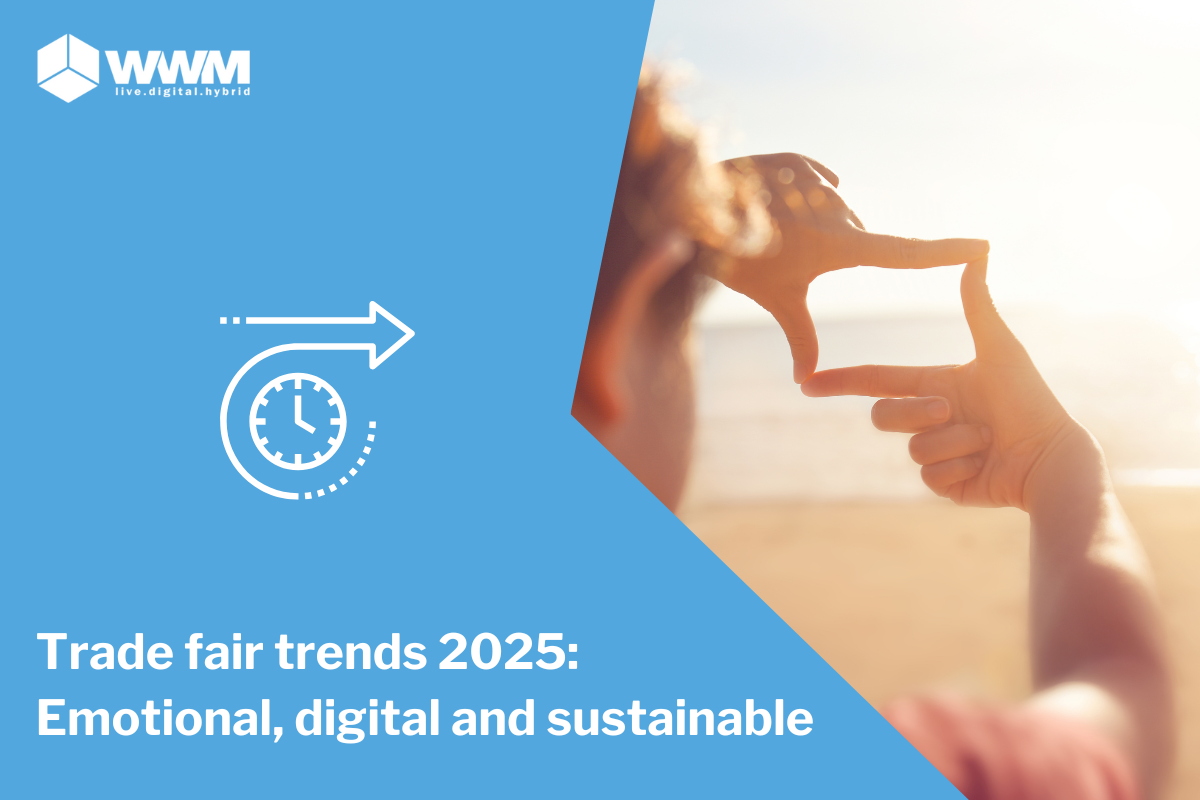The psychology behind stand construction: influence emotions
Trade fairs are vibrant melting pots of commerce and innovation, where companies and customers meet in a dynamic environment. But what is often...
8 min read
 Maaike Rotthier
:
Friday, 19. April 2024
Maaike Rotthier
:
Friday, 19. April 2024

The customer journey plays a central role in event management. Planning and executing events is not just about putting together an impressive programme or ensuring that everything runs smoothly. It's about understanding the steps that potential attendees take from their first interaction with your event through to long-term engagement with your brand and organisation. This journey is key to the success of any event. In this blog post, we will look at the different stages of this journey in the context of event planning and management to show you how to operate effectively at each stage to realise the full potential of your event or trade show presence and create memorable experiences for your attendees.

The discovery phase, also known as ‘awareness’, marks the beginning of the customer journey. Here, potential customers are in the phase of familiarising themselves with your event or your brand. They may not even have heard of your event or know what you have to offer. The primary goal is to attract the attention of the target group and gain their interest. This stage is all about putting your brand or event in the spotlight and attracting the attention of potential attendees. To achieve this, it is crucial to utilise a variety of marketing strategies to increase visibility and reach potential attendees.
Phase 1: Awareness - The journey of discovery

After potential participants have heard about your event, they are now in the evaluation phase. The focus here is on building trust and emphasising the benefits of your event. To convince potential attendees, it is crucial to provide them with detailed information about your event. Testimonials from previous attendees or case studies can help build trust. Additional incentives such as early bird discounts or exclusive access can further increase interest.
It is also important to give potential attendees the opportunity to actively engage with your event. This can be done through information sessions, webinars or live Q&A sessions where open questions can be clarified and potential attendees can learn more about your event.
The evaluation phase offers a significant opportunity to convince potential participants and convert their interest into a concrete registration. By providing targeted information, additional incentives and opportunities for interaction, you can increase the engagement of potential participants and further promote the success of your event.
Phase 2: Consideration - The evaluation phase

Once potential attendees have gathered enough information in the evaluation phase, they are now in the decision phase to evaluate your event and decide whether they want to attend. This stage of the customer journey is crucial as it is all about convincing attendees and making it easier for them to register.
An important step to support attendees is to design a clear and straightforward registration process. This means providing user-friendly forms, offering transparent information on pricing and payment methods, and providing support for questions and concerns.
Pricing also plays an important role. With attractive offers such as early bird discounts or special online ticket prices compared to the box office, you can encourage potential participants to register.
Overall, it is crucial to present a compelling offer to prospective attendees and ensure a smooth registration process. By targeting their needs and providing attractive incentives, you can increase the conversion rate and further boost the success of your event
Phase 3: Decision - The decision phase

In the decision phase, potential attendees have thought carefully about whether they want to attend your event. However, these considerations do not mark the end of their journey, but initiate the transition to an equally important phase: the retention phase. Here, in phase 4 of retention, it's not just about attracting attendees to the current event, but also creating long-term bonds that strengthen their connection with your brand and company and encourage them to attend your events in the future.
In the retention phase, you deepen the interaction with participants and build long-term relationships. It is crucial to keep them engaged after the event and offer added value. Through targeted communication and relevant content, you can maintain interest and strengthen engagement with your brand and company, be it through regular updates, newsletters or invitations to further events.
An effective way to strengthen engagement is to follow up on the event. This includes thank you emails with additional resources or materials, as well as gathering feedback to continuously improve the event and understand attendee needs. There are also opportunities for follow-up events or regular meet-ups to encourage sharing and create a strong community around your brand that fosters long-term bonds and engagement.
Phase 4: Retention - the bonding phase

When customers are satisfied with their experience, they often develop a strong attachment to your brand or events. In the retention phase - also known as the bonding phase - they build long-term relationships that mark the transition to the next crucial phase: the advocacy phase, also known as the endorsement phase. This is where satisfied customers become active supporters of your brand or events by sharing their positive experiences with others and acting as brand ambassadors. This transition is a significant milestone in the customer journey, as customers not only become loyal followers, but also active advocates for your brand, helping to expand your customer base and drive growth for your business.
In the advocacy phase, it is crucial to further strengthen the commitment and loyalty of your customers in order to fully exploit their potential as ambassadors for your brand. Through targeted measures, you can ensure that your customers are motivated to share their positive experiences and convince others of your product or event. This can be done, for example, by providing incentives for referrals, exclusive rewards for advocates or involvement in special community promotions. By encouraging active sharing and a positive community around your brand, you can further increase your customers' willingness to advocate and build long-term relationships that go beyond individual transactions.

Reach: Measuring the number of potential customers who become aware of your event content
Traffic sources: Analyzing the origin of website traffic (e.g. search engines, social media, direct traffic) to identify the most effective channels.
Impressions and interactions: Tracking impressions, clicks, likes, shares, etc. to measure engagement with your content.
Lead generation: Capture qualified leads that show interest in your event.
Engagement rate: Measurement of interactions with specific event content such as webinars, information events, etc.
Dwell time and page views: Analyzing dwell time and page views on relevant web pages to understand interest and depth of evaluation.
Conversion rate: Proportion of visitors who register for your event or take specific action (e.g. request additional information).
Registration rates: Recording the number and quality of event registrations.
Abandonment rates in the registration process: Analysis of the steps in the registration process to identify and minimize obstacles.
Participant satisfaction: Measurement of participant satisfaction through feedback surveys or evaluations.
Repeat rate: Proportion of participants who attend previous and future events.
Community engagement: Analysis of activity and participation in online communities or post-event platforms.
Net Promoter Score (NPS): Measurement of the likelihood that participants will actively recommend your event or brand to others.
Social media shares and recommendations: Tracking shares, comments and recommendations on social media platforms.
Attendee acquisition through referrals: Recording the number of new attendees who come as a result of recommendations from existing attendees.
Continuously monitoring and analyzing these KPIs provide event planners and managers with valuable insights to measure the success of their events at every stage of the customer journey. By adjusting strategies and measures, optimizations can be made to build long-term relationships with attendees and increase engagement.

Considering all five phases of the customer journey is crucial to building long-term relationships with your attendees and making your event portfolio successful.
The journey begins in the awareness phase when potential attendees become aware of your event. This is followed by the interest phase, where you pique their interest and convince them of the benefits of your event. The decision phase is critical as it is about persuading participants to register. In the retention phase, you build long-term relationships that mark the transition to the advocacy phase, where satisfied attendees become advocates of your brand.
The effective design and implementation of marketing and communication strategies at every stage makes it possible to appeal to potential participants, arouse their interest, influence their decision and build long-term relationships. Through targeted content marketing, search engine optimization, social media marketing and the use of various event formats, event planners can optimize the customer journey and increase the success of their events.
In addition, strategies for attracting, retaining and nurturing participants after the event play a crucial role in strengthening customer loyalty and promoting advocacy. Taking the entire customer journey into account enables event professionals not only to create successful individual events, but also to build long-term relationships with their participants and sustainably expand their event portfolio. It is therefore essential to understand the needs and expectations of customers at every stage and take appropriate action to maximize their experience and satisfaction.

Trade fairs are vibrant melting pots of commerce and innovation, where companies and customers meet in a dynamic environment. But what is often...

In recent years, trade fairs have evolved from mere platforms for product presentations to important touchpoints for brand-building experiences....

In today's trade fair world, it's not just about presenting products or services - it's about standing out. At trade fairs, visitors are surrounded...